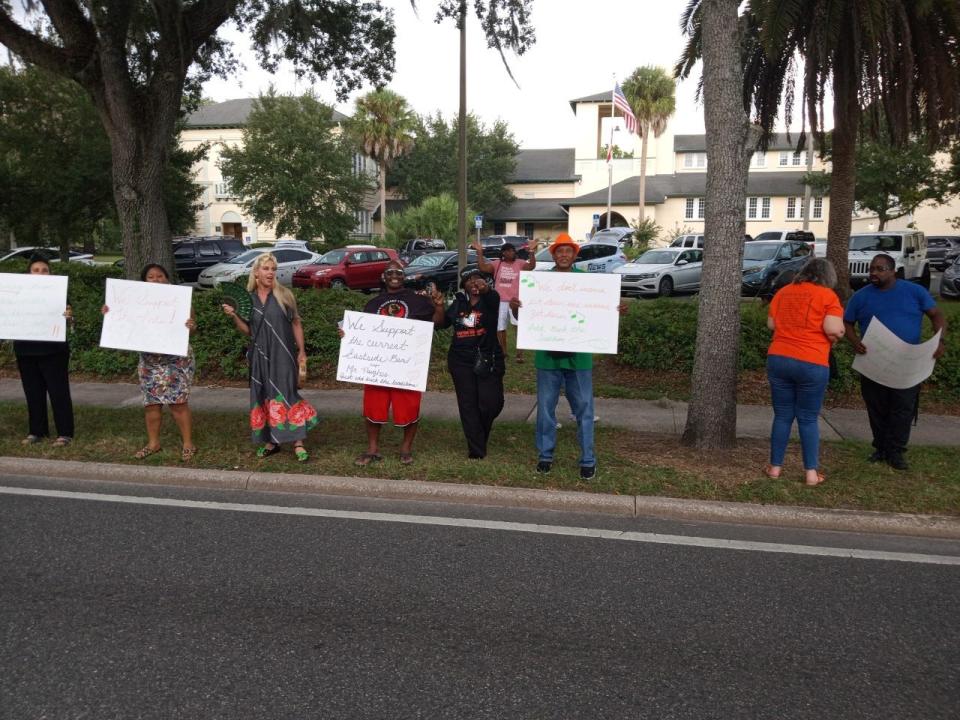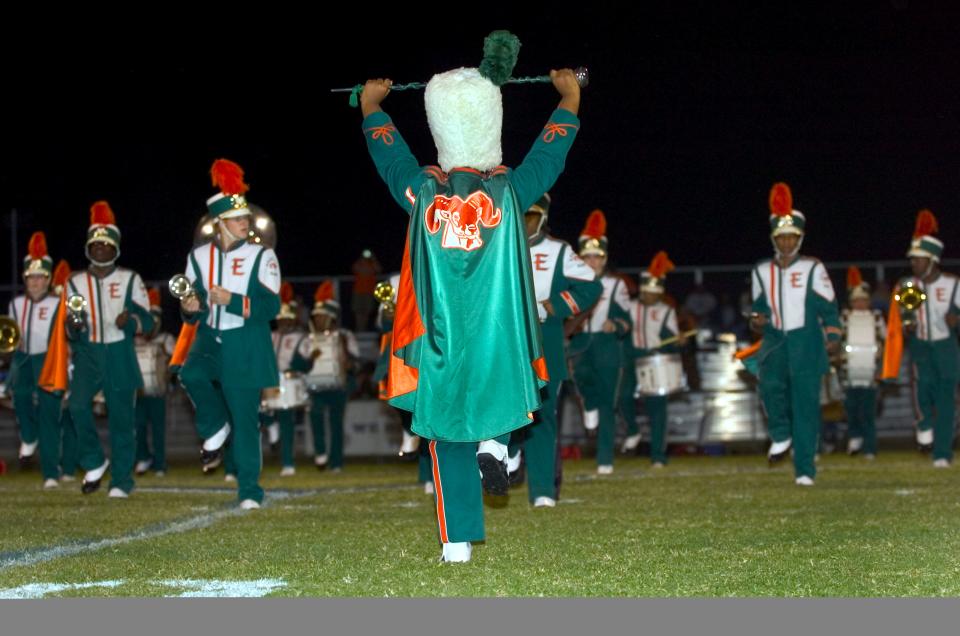Former EHS band members want old style back, current band members say band is great as is
Restoring the culture and tradition of the Eastside High School band is the top priority for members of the Richard E. Parker Alumni Band.


With that in mind, members of the alumni band and the school's alumni association and other supporters attended the Alachua County School Board meeting last Tuesday night to let their concerns be known that they wish to have the "show band" style of marching and performing be incorporated in band routines performed by Eastside's marching band.
Cathy Norman, president of the Eastside High School Alumni Band, said Joseph Hughes, Eastside's band director, is a good instructor and that all the alumni is asking for are a little classical music and modern music mixed in with tradition.
The issue became divisive during the School Board meeting Tuesday night when current Eastside band members came to the defense of Hughes by saying the band does perform the traditional style sometimes. In fact, the band during football games routinely plays "Let's Go Eastside," which is its own rendition of the popular chant made popular by the Bethune-Cookman University Marching Wildcats band.
Maryanne Armstrong, a drum major in the band and a student in the International Baccalaureate program, said the four words she would use to describe Eastside's band are "hype, family, accountability and tradition."
"It's something that I hope to keep implementing," Maryanne said. "If it were up to me every single student would be a part of the band. I want to build a culture in band and I want more people in it."
Those who want the traditional Eastside show band style incorporated more in the band's performances say there are more IB students in the band than just regular students. The IB program is a college preparatory curriculum that focuses on classical liberal arts and sciences.
Prior to Hughes becoming director of the band in 2009, the band had reached a low of 20 members, but has grown ever since.
In a past interview with The Gainesville Guardian, Hughes said it has taken a lot of hard work to get the band back to being a source of pride for the Eastside family. He said a lot of students and their families put the work in to make the band successful again. He also said having a successful band is important to him because it is important to his students.
“Band is really a vital part of people’s lives,” Hughes said.
He said the successful “re-growth” of the band is almost exclusively because of the great leadership the students have shown. He said students take a lot of pride in the band and how it represents Eastside and he is indebted to the students who have decided to make the Eastside band great again.
"I hear a lot of talk about the band being mostly IB kids and mostly white kids," said Deshawn Johnson, a band member who spoke Tuesday at the School Board meeting. "There's a lot of kids in the band. We come from different backgrounds, we come from different cultures and I think that's something that we should focus more on rather than the things that make us different."
School board member Leanetta McNealy thanked everyone for attending the board meeting.
"My wish and recommendation after being involved in conversations with some of the school district leadership is to have a meeting where every voice is heard...we should come together and not be divided. I know that we can mitigate changes from the past and reach a peaceful solution or resolution," McNealy said.
School board member Tina Certain suggested the district use Elementary and Secondary School Emergency Relief Fund money (ESSER) funds to create an after-school program so younger students can get music instruction and join the band. ESSER funds are provided by the federal government to states and local school districts to help with the learning loss that has occurred during the pandemic.
Certain requested that Alex Rella, chief of finance, and Jennie Wise, chief of teaching and learning, come to the board sometime next month with a plan to get younger students involved.
Those who organized a protest before the meeting demand that the school add the original historically Black college and university style of marching and performing back to the current "corps-style" band performances.
The alumni band is named in honor of Parker, the school's first band director who led the marching band from 1970 to 1990. In 2017, a year after his death, Southeast 12th Avenue that leads into the south side of Eastside was renamed Richard E. Parker Way.
Under his leadership, the Marching Ram Band adopted the orange and green look of Florida A&M University and the entertaining dance moves of the internationally renown FAMU Marching 100 Band, of which Parker was a member after graduating from former all-Black Lincoln High School, which is now Lincoln Middle School in southeast Gainesvlle.
Lincoln High School was the only high school in East Gainesville when it closed in 1970 and replaced by Eastside as the only high school in East Gainesville.
"We were known as little FAMU," said Alonzo Young, a graduate of the first graduating class of EHS in 1973.
Young's love for Louis Armstrong led him to choose the trumpet as his instrument for the band, and Parker's passion for music helped Young stay on the right path in his life.
"If it wasn't for Parker, I would be in prison, on drugs or dead," Young said.
Young said he is devastated to see his alma mata's band not use the traditional show band style the band became known for during Parker's tenure as band director. During the band's heyday, it's performances were one of the main highlights of the University of Florida's annual homecoming parade.
"We would like to have our culture and tradition restored," Young said.
Parker was tasked with starting one of the counties first integrated marching bands, and Young said both white and Black students worked together to make one sound under the leadership of Parker, whether it was the traditional show band or classical styles.
The marching band used to reflect the school's majority Black population and its surrounding neighborhoods, but today it has very few Black students in the band, Young said.
"Whatever your status was you were accepted," Young said. "It was a melting pot of white and Black people. Parker welcomed everyone."
Jill Dumas, who graduated from EHS in 1995, was a majorette and a baton twirler. Dumas said Parker's legacy still lived on with the seniors in the band after his retirement.
"Being in the band was a sense of pride," Dumas said. "Some students do not want to be in the band because it doesn't represent them. That's not the culture I grew up in. The band is what kept us out of trouble and what kept me going and what pushed me to go to college."
Dumas said since Parker's retirement, she has noticed his traditional band style changing within the band.
"We want to preserve the heritage, the history and the tradition that helped create the sense of belonging to the east side," Dumas said. "Seeing the graduating classes fight to keep the tradition should show how much it means to the people. That's what binds us together — the band."
Black and white alumni band members said the refusal to incorporate the traditional style is detrimental to students at the school.
Norman, the alumni band president, who graduated from EHS in 1983, said the protest is bigger than music.
"One style shouldn't be more important than the other," Norman said. "Don't downplay the HBCU style. Every week we would learn 10 to 20 songs and had to have the music and routine memorized. It takes a special band director to pull that out of kids."
Norman said music helps students in all facets of life such as reading, math and science, and bringing back the traditional style could increase the number of Black and brown students in the band.
Chanae Jackson, a 1997 EHS graduate, said she was on the color guard in the band.
She became a member of the alumni band in 2016 and noticed the challenges getting the school and former band members to collaborate to increase Black representation in the band and show band style marching and performing.
Although there have been joint performances with the alumni band and current bands, Jackson said Hughes have not address their request to reincorporate the HBCU style for the students.
"This is an equity issue," Jackson said. "We want to let people know that Black students matter and Black families matter, and how it's important to collaborate. We are also advocating for Black faculty and staff in the public schools and this also addresses the school to prison pipeline."
Jackson said the issue is about continuing the legacy and for students to remember and cherish it.
"We want what's best for our students," Jackson said. "It's about the legacy that was left behind. We did corps-style marching and the traditional style."
This article originally appeared on The Gainesville Sun: Eastside High School band topic of discussion at School Board meeting

